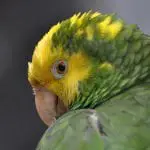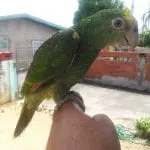Scientific Facts
| Common Name | Yellow-naped Amazon |
| Scientific Name | Amazona auropalliata |
| Lifespan | 40 – 60 Years |
| Size | 14 inches (35cm.) |
| Body Mass | 17 – 19.5oz. (480 – 550 grams) |
| Habitat | Savanna woodland, clearings, evergreen forest, deciduous forest |
| Range | Along the Pacific Coast |
Information & Physical Appearance

The Yellow-naped Amazon (Amazona auropalliata) phrases in the order Psittaciformes, the family Psittacidae, the Amazona genus.
Other common names include Yellow-naped Parrot, Golden-naped Amazon/Parrot, and Honduras Yellow-naped Amazon/Parrot.
Up-to-date, there are three recognized subspecies, including the nominate race.
1. A.a.auropalliata
In both sexes, adults are identical in physical appearance. Mature auropalliata Amazons’ forehead is green, and so is the area that starts from the crown and extends around the eyes.
There is a yellow patch from the hindneck to the lower nape. The extent of yellow coloring in these particular zones varies among individuals.
The red coloring that is visible on the bend of the wing in other Amazona species is absent in the members of the auropalliata race, and so is the yellow coloring on the thighs.
The bill is colored in dark grey, becoming paler towards the base and on the sides of the upper mandible. The feet are dark grey, too.The eye ring displays grey coloring and is narrow in shape.
2. A.o. parvipes
Adults of both sexes resemble very closely the external appearance of auropalliata adults. However, the yellow coloring on the nape is more extensive in parvipes.Also, even though occasionally, the members of the parvipes race may exhibit other yellow markings on the forehead.
Unlike the case with auropalliata, there is red coloring on the bend of the wing.
Another difference is that in parvipes the bill is colored in pale gray, and is further characterized by dark grey markings.
3. A.o. carbaea
Carbaea adults closely resemble parvipes adults. However, members of the carbaea race display more green/olive coloration on the underparts.
Also, this subspecies’ plumage is paler overall. The lower mandible’s color is grey/horn.
Juvenile
Juveniles have dark grey bills and brown eyes. They differ from adults because of the absence of yellow coloring on the neck, as well as on the head.
Lifespan
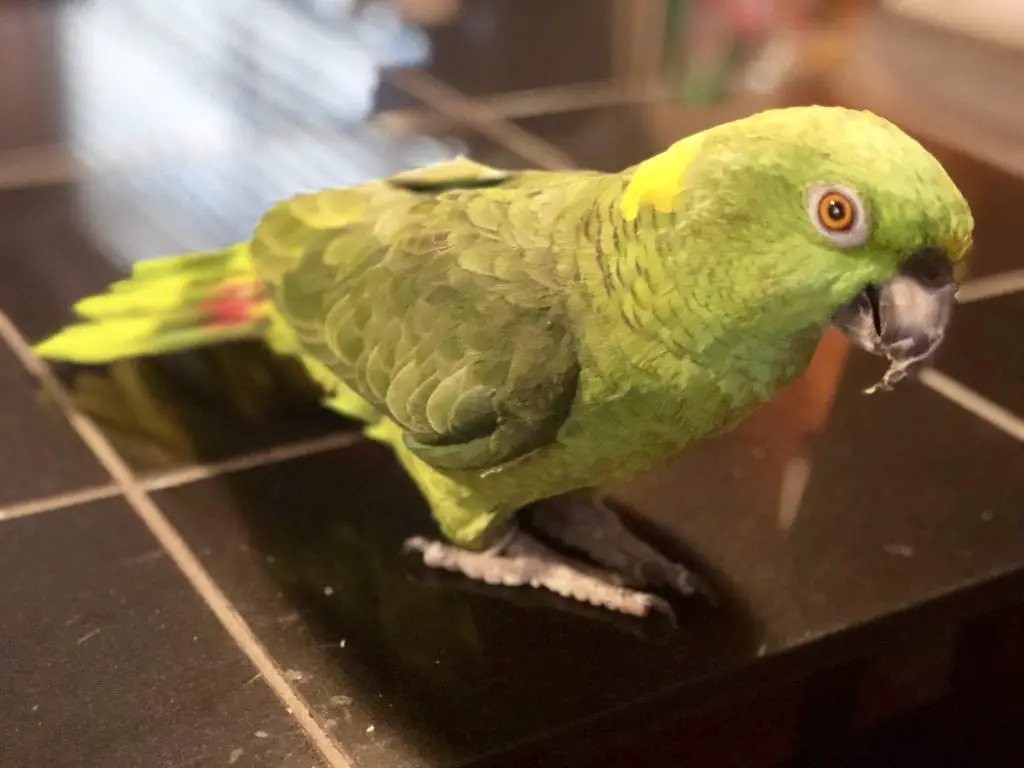
Yellow-naped Amazons are quite long-lived parrots. They usually live for between 40 – 60 years in captivity, as long as proper care, socialization, nutrition, and nonetheless, exercise is provided by the caregivers.
The generation length is estimated at 12.3 years.
Ecosystem & Habitat
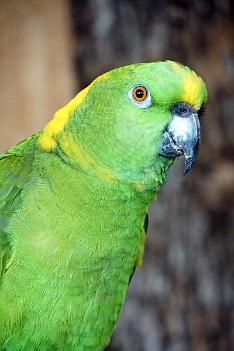
Yellow-naped amazons are permanent residents along the Pacific Coast, more specifically, in northern Costa Rica and southern Mexico.
RANGE
A.a. auropalliata is found in the Pacific slope, ranging from northwestern Costa Rica to Mexico and Oaxaca.
A.a. parvipes occurs in northeastern Nicaragua and Mosquitia of Honduras. It is also known as Honduras Yellow-naped Amazon.
A.a. caribaea is native to Bay Islands (Honduras). It is also known as Roatán yellow-naped Amazon.
HABITAT
Just like other Amazona species, Yellow-naped Amazons are known for their high adaptability.
They can be found in a variety of habitats, including savanna woodland, clearings, evergreen forest, deciduous forest, dense gallery woodland, and Pinus woodlands.
Although less common, they can be also found in dry thorn forests, cultivated areas characterized by scattered trees, mangroves, and coastal swamp forests.
Food & Diet
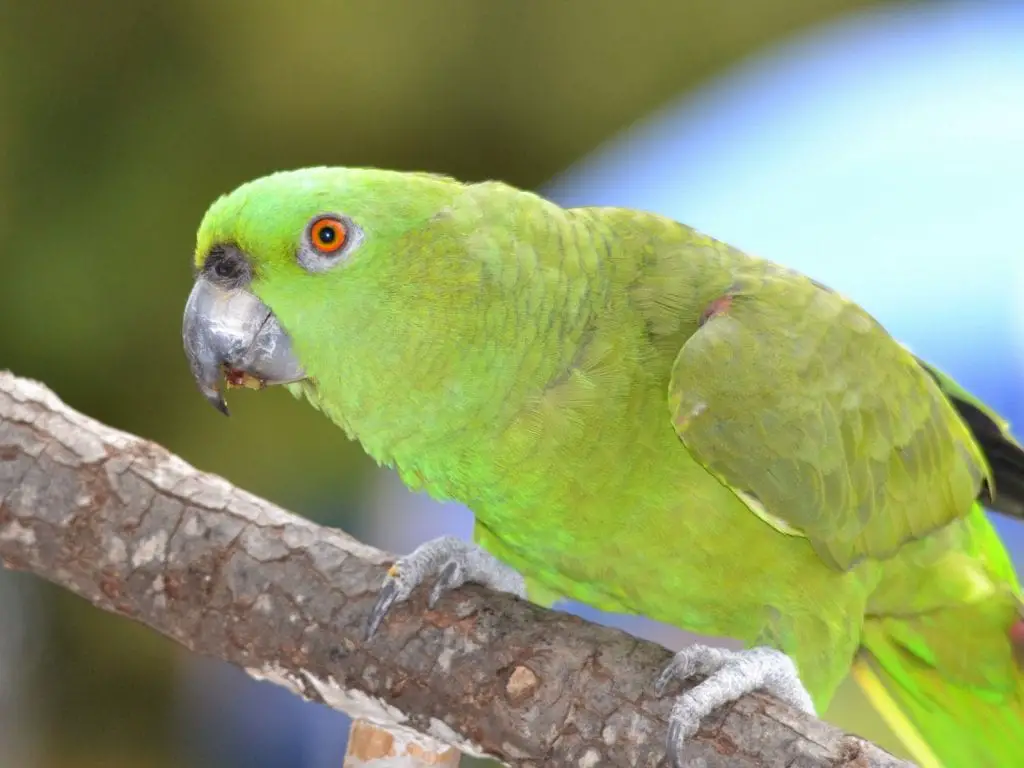
The wild diet of yellow napes consists of various berries, seeds, nuts, and fruits, such as the seeds of Curatella (genus in the family Dilleniaceae) and Cochlospermum (genus of tropical trees).
Figs are especially favored, and so are the ripening fruits of Terminalia plant species. Terminalia fruits are commonly referred to as Belliric myribalon.
The yellow napes found in Bay Island, Honduras are also known to feed on pine cones.
Behavior
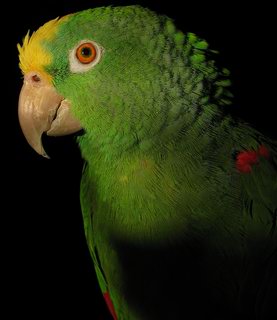
Yellow-naped Amazons, just like other Amazona species, are renowned for their social nature. They are usually found in flocks or in pairs.
At feed areas, as well as at communal roosts, yellow-naped Amazons gather in large numbers.
They are strictly monogamous and form an exceptionally strong bond to their mating partner.
Their calls include a wide variety of whistles, screams, and squawks, and very specific, deep rolling “karr-ow karr-ow” sounds.
Reproduction
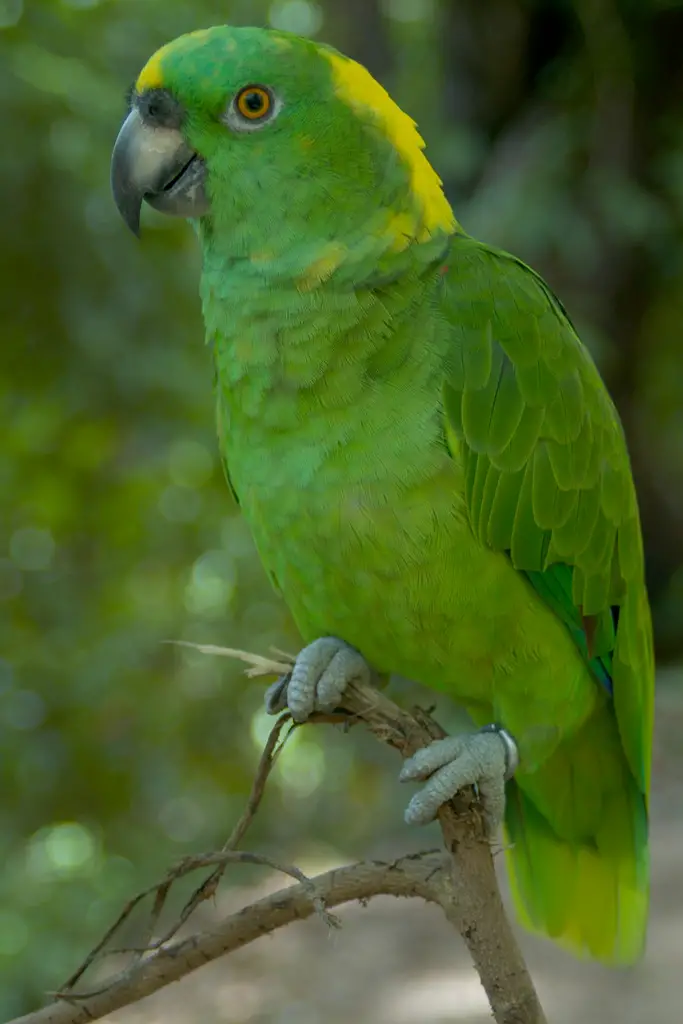
Yellow-naped Amazons’ breeding season starts at the beginning of February and continues up until the end of the month.
Yellow napes are cavity-nesting birds. They are well-known for their nest-protective behavior when they can become quite aggressive and attempt to bite while defending their nests.
Aggressive behavior during the breeding season is particularly common in males.
Females are to lay between 2 and 4 eggs. The eggs are ovate and measure 1.4 x 1.3 inches.
Survival Threats & Conservation
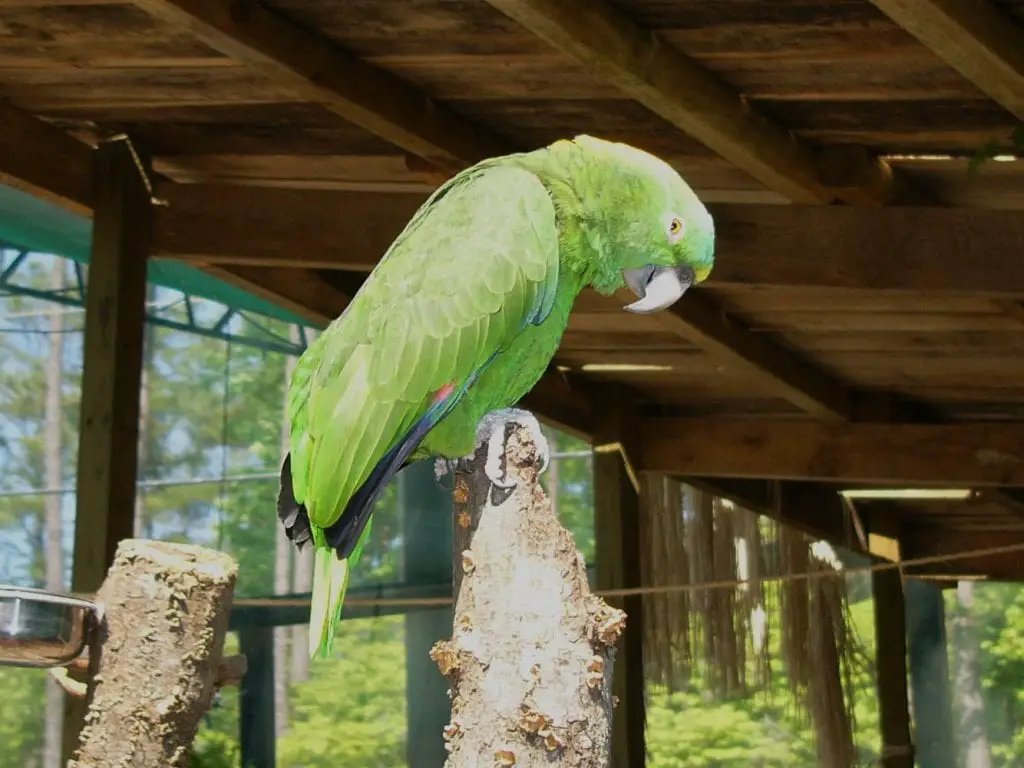
Yellow-naped Amazons are listed on CITES’ Appendix I.
Also, they are listed under the Endangered category on the IUCN Red List of Threatened Species.
While there is control over the illegal trade of these unique parrots, they keep being heavily captured for both the local and international wild bird market.
Other major survival threats include habitat loss and degradation, greatly driven by deforestation due to the expansion of agriculture (livestock ranching and farming, as well as marine aquaculture).
Nonetheless, climate change does pose serious threats to the future survival of Yellow-naped Amazons in the wild due to the extensive, abnormal droughts.
Sadly, the population trend is estimated to decrease. The world population of yellow napes is as low as 10 000 mature individuals. In the Pacific lowlands of Costa Rica and Nicaragua, there are as few as about 1700 yellow napes left.
On the bright side, there is an active recovery plan in motion. However, there is no systematic monitoring scheme. Conservation sites are identified over the entire area, and the species occurs in at least one protected area.
Availability – Where to Get a Yellow-naped Amazon
Yellow-naped Amazons are among the most sought-after pet parrots in the world, mainly due to their vivid coloration and impressive talking abilities.
Being quite popular and desired pets, it is easy to acquire a yellow-naped parrot from a variety of avian-specialty stores and breeders.
Also, one can choose to adopt a yellow-naped amazon. However, if this is the case, the potential caregiver should make sure to ask about the history of any mature individual.
Past trauma, bad habits, and nonetheless, poor taming often result in yellow napes being almost impossible to rehabilitate.
Yellow napes that have been poorly treated and/or neglected can easily fall victim to destructive behavior patterns and depression manifested in different emotional and physical problems, such as biting people and/or feather plucking, among others.
Prior to acquiring a yellow-naped amazon, you need to consider carefully the amount of time and attention you will need to dedicate to your feathery fellow on a daily basis.
Taking care of such an emotional and intelligent creature is much like taking care of a human toddler. Altogether with yellow napes’ long lifespan, mind that caring for these amazing living beings is a serious, long-term commitment.
Interesting Facts
1. There is an extraordinary, rare mutation of the yellow-naped amazon: a blue mutation. The entire body is vivid turquoise in color.
2. If you have ever enjoyed watching a talking parrot on TV, then there is a huge probability that it was none other but an Amazon parrot.
What’s even more amazing to find out is that in many cases, when other types of parrot TV stars appear to be talking, they are actually “beak-synced.” So, in reality, you heard an Amazon parrot’s voice!
A curious beak-synced example: It was in 2009 when Pepper – an African grey parrot – was purported to sing the National Anthem on Animal Planet’s Puppy Bowl program. While Pepper was seemingly kicking off the game, he was actually just mouthing along to a recording of Boozle – a Yellow-naped Amazon!
3. Sometimes, the Yellow-naped Amazon is considered a subspecies of its close relative – the yellow-crowned amazon.
How to Care for the Yellow-naped Amazon
1. Housing & Cage Accessories
Yellow-naped Amazons require a spacious cage. Ideally, you should house a yellow nape in an aviary. However, a suspended cage can also work well.
In either of these cases, the enclosure has to be at least 9.8ft. (3 meters) in length.
Providing a variety of toys is crucial. Yellow napes are avid chewers.
Owners need to offer both destructible and non-destructible toys, such as foot toys, woodblock toys, leather toys, food-finder toys, push-and-pull toys, and preening toys.
Also, differently-sized hanging perch toys of varying texture should be provided. Enrich the enclosure and other parts of the play area outside the cage with pine, willow, fir, and/or elder branches.
Note that bathing is especially important, so you want to make use of shallow water bowls and/or suitable overhead misters.
Mist your yellow nape with clean water once or twice every day. Apart from being an extremely enjoyable process, bathing has health benefits for your feathery friend, as it is known to improve respiratory function.
2. Diet
About 30% of a healthy captive diet should consist of bird-safe fruits and vegetables served in moderate amounts every day.
These include but are not limited to bananas, pomegranate, cactus fruits, oranges, apples, pears, green peas, green leaves, fresh corn, cooked or sprouted pulses and beans, carrots, and celery.
About 70% of a balanced diet should be made up of a mix of small seeds (make sure to limit sunflower seeds and stick with low-fat seeds), and spray millet.
Complete kibble is a must.
3. Speech and Sounds
As a rule of thumb, yellow napes are known to use their parrot-voices intermittently.
They are not considered the noisiest Amazons out there.
However, they do have their moments and can be very loud when they choose to.
Yellow-naped amazons are especially favored for their impressive talking abilities. With proper training, they can hardly be out-talked by any other Amazona species, and this refers to both the clarity and the quantity of speech.
4. Personality & Handling
Yellow-naped amazons are affectionate, highly intelligent, playful, social, active, and everything in between.
Sometimes, they may fail to handle their emotions well. On the bright side, though, they usually signal when feeling over-excited or stressed by contracting and expanding the pupils of their eyes (aka eye pinning) and by fanning their tail.
If the owner is to notice any of these signs, it is best not to handle the parrot before it is allowed to calm down. Or else, the parrot may attempt to bite.
Do note that yellow napes tend to be one-person birds.
While they can have a strong bond with other family members, they typically bond especially strongly and deeply to one member of the household and may be quite jealous of others (whether it comes to other people or other pets).
It is important to note that if a yellow-naped parrot is well-socialized and interacted with on a daily basis, the bird can feel quite comfortable being around humans and animals alike.
5. Common Health Issues
Some of the most common conditions and diseases that affect Amazon parrots include Chlamydiosis, Vitamin-A deficiency, and Polyomavirus.
However, with proper care, yellow napes are quite hardy creatures and do rarely encounter any serious health issues.
Do mind that you need to prevent weight gain as they are prone to becoming obese.
Your yellow nape should spend at least several hours every single day out of the cage. Thus, the bird can stretch its muscles and burn excess calories while also being provided with mental stimulation.
FAQ Section
Are Yellow-naped Amazons Good Pets?
Yellow-naped Amazon parrots can be good, and in fact, great pets for people who are willing to dedicate a proper amount of their time and attention to cater to these birds’ high intelligence and social nature. They are playful, moderately-sized, fantastic talkers, and some of the most popular companion birds all over the world.
How Long Do Yellow-naped Amazons Live?
When given proper care, yellow-naped amazons can easily live up to 60 years. On average, their lifespan is estimated at between 40 – 60 years.
How Much Does a Yellow-naped Amazon Cost?
Because of their uniquely talkative, playful nature, yellow-naped amazons typically cost around $1200 – $2500.
Do Yellow-naped Amazons Talk?
Yes, yellow-naped amazons can talk excellently. Their clarity of speech and the volume of words and phrases they can learn is absolutely impressive, so they can hardly be outtalked by any other Amazon parrot.
What Do Yellow-naped Parrots Eat?
In captivity, yellow-naped parrots should eat a varied diet, with a high-quality pelleted diet further supplemented with limited seed mix accounting for about 70% of their food. Also, daily servings of bird-safe, fresh fruits, and veggies should be provided, ensuring that the yellow nape pet gets a good balance of vitamins and nutrients.
Are Yellow-naped Amazons Loud?
Yellow-naped amazons can be quite loud at times, although they are not regarded as the loudest/noisiest of all Amazon parrots. With proper training and socialization, a yellow nape’s loud moments can be brought to a fairly tolerable level.
Are Yellow-naped Amazons Endangered?
Yes, Yellow-naped Amazons are endangered with extinction, and the population trend is decreasing. They have listed on CITES’ Appendix I, as well as under the Endangered category on the IUCN Red List of Threatened species.

